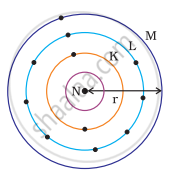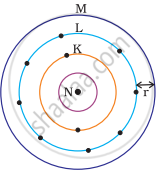Advertisements
Advertisements
Question
Write an Explanation.
Atomic radius
Solution
For an isolated atom, the distance between the centre of the nucleus of the atom and the outermost shell is called its atomic radius.
APPEARS IN
RELATED QUESTIONS
Answer the following in respect of element `31/15 P`
Give its electronic configuration
Arrange the elements of second and third periods in increasing order of their atomic size (excluding noble gases).
Write scientific reason.
Atomic radius goes on increasing down a group.
What happens to the atomic size of elements on moving from left to right in a period?
The following questions refer to the Periodic Table.
What happens to the atomic size of elements moving from top to bottom of a group?
The changes in the properties of elements on moving from left to right across a period of the Periodic Table. For the property, choose the correct answer.
The atomic size:
Moving from left to right, the size of the atom decreases.
Write scientific reason.
In same period, boron and oxygen elements have different atomic size.
When an atom of iodine becomes an iodine ion (I–) the radius will ______
Which of the following gives the correct increasing order of the atomic radii of O, F and N?
Which among the following elements has the largest atomic radii?
Which one of the following depict the correct representation of atomic radius(r) of an atom?
|
(i) |
(ii) |
|
(iii) |
(iv) |
An element X (atomic number 17) reacts with an element Y (atomic number 20) to form a divalent halide.
- Where in the periodic table are elements X and Y placed?
- Classify X and Y as metal (s), non-metal (s) or metalloid (s)
- What will be the nature of oxide of element Y? Identify the nature of bonding in the compound formed
- Draw the electron dot structure of the divalent halide
- Electropositive nature of the element(s) increases down the group and decreases across the period
- Electronegativity of the element decreases down the group and increases across the period
- Atomic size increases down the group and decreases across a period (left to right)
- Metallic character increases down the group and decreases across a period.
On the basis of the above trends of the Periodic Table, answer the following about the elements with atomic numbers 3 to 9.
- Name the most electropositive element among them
- Name the most electronegative element
- Name the element with smallest atomic size
- Name the element which is a metalloid
- Name the element which shows maximum valency.
Arrange the following in order of increasing radii:
Cl−, Cl
Explain your choice.
Arrange the following in order of increasing radii:
N, O, P
Explain your choice.
Give reason for the following:
The size of a Cl− ion is greater than the size of a Cl atom.
This question refers to the elements of the Periodic Table with atomic numbers from 3 to 18. Some of the elements are shown by letters, but the letters are not the usual symbols of the elements.
| 3 | 4 | 5 | 6 | 7 | 8 | 9 | 10 |
| A | B | C | D | E | F | G | H |
| 11 | 12 | 13 | 14 | 15 | 16 | 17 | 18 |
| I | J | K | L | M | N | O | P |
Which of these have least atomic size in period 3?




